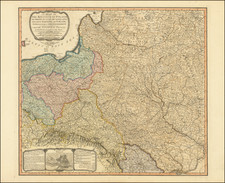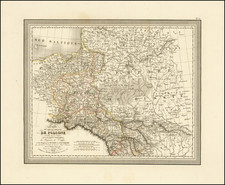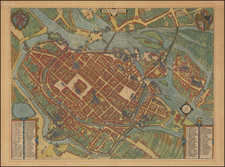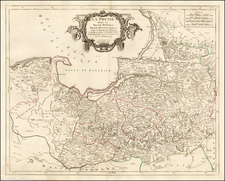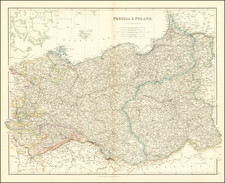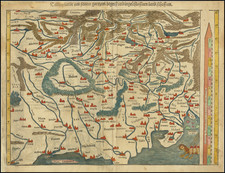A Censored Modernist Cartographic Monument to the Destruction Warsaw Suffered During the Second World War.
Exceptional post-World War II map of Warsaw showing the extent of the damage the city suffered during the war.
The map was printed in 1948, and dated 1949, by the Biuro Kartograficzne GUPK. It depicts the near-total destruction of the city by German armed forces during the Second World War with an effective color palette and graphic design. The map is the first of its kind to do so. Polish technical and cartographic services were in ruins in the mid-1940s, so the map was drafted from Soviet aerial photographs taken in the spring of 1945.
Germany took Warsaw in September 1939, with Hitler initially intending to destroy the city and build a Germanized version. As the Red Army neared the city in 1944, the hope of impending liberation led local resistance and Home Army fighters to attempt to retake the city as the Germans were retreating. Infamously, however, the Red Army halted combat operations on the outskirts of Warsaw, allowing the SS and Wehrmacht to crush the resistance and destroy the city in retaliation. The destruction focused specifically on the Old Town and Warsaw Ghetto areas. The text at the lower right part of this map says: "84% zniszczeń / of destruction" – and this is no exaggeration. Currently, historians estimate that close to 90% of the buildings in the city were destroyed.
The map was reprinted in 1984. As the author, Felicjan Piątkowski, mentions in the preface to that reprint, he deliberately chose the red color to show the destruction as it resembles blood spots and shows the city’s suffering. This was also expensive: most of the maps done post-WWII were black and white or printed in two or three colors. So this map really stands out.
It can be noted that the map rarely mentioned separate buildings in any neighborhood: the scale of destruction was so enormous that the mapmakers were unable to pinpoint the remnants of the exact building. This is why the blue marks in the sea of brown and red are so important: they are showing the only miraculously surviving pieces of pre-war city center architecture, including some sites important for Jewish culture such as Synagoga Nożyków - the only intact synagogue in Warsaw. During the 1940s this building was used by German armed forces and it was spared from destruction.
The map title and map legend are bilingual, in Polish and English:
[Light brown] – Building grounds
[Dark green] – Ploughed land
[Light green] – Meadows and uncultivated land.
[Red and blue tunnel symbols] - Destroyed bridges and tunels [sic]
[Brownish green] - Parks and groups of old trees destroyed by the Germans.
[Brown] - Buildings destroyed by systematic mining and, in part, bombs.
[Orange] – Buildings destroyed by systematic setting on fire.
[Blue] - Buildings which the Germans have not succeeded in destroying.
Possibly, it was made bilingual for the teams who were planning the reconstruction works. In 1950, the 6-year plan of the reconstruction of Warsaw was issued – it used this map as the basis.
The Polish government took enormous efforts to collect bits of information on the general outlay and architecture – everything was used to rebuild the city center just as it was. Also, sites for the new skyscrapers were carefully integrated into the landscape of the old town. Construction work was curated by Warsaw Reconstruction Office – and it took six years (!) only to plan the reconstruction. It took Poland more than 20 years and tens of billions of dollars to rebuild the city. It was a major cultural and psychological trauma for the Polish people and Polish society. Currently, the rebuilt Warsaw city center is a UNESCO heritage site.
The Warsaw Ghetto
By late 1940, tens of thousands of Jews were imprisoned in the Warsaw ghetto, and modern estimates count as many as 450,000 prisoners. 390,000 Jews from the Ghetto were killed either directly by soldiers or transferred to extermination camps. In 1943, the famous Ghetto Uprising took place. The German armed forces suppressed the Ghetto Uprising and destroyed much of the neighborhood, culminating in the destruction of Wielka Synagoga in May 1943. The Ghetto was completely emptied of inhabitants.
"GHETTO" is lettered in black across the “Large Ghetto” area.
Censorship
In 1949, the map initially passed the Soviet censors (bearing the censor mark B-57918) and was printed in a run of 12,500 copies. According to research in the state cartography archives by Dr. Hab. Beata Konopska, there was a plan to continue printing an additional 12,500 copies, but this was halted by the censorship committee and the map was never distributed.
In an article for 1984 reprint, the author of the original map, Felicjan Piątkowski mentions that he did not know the exact reasons why the map was discontinued. But Piątkowski's words are supplemented by the other author of the text for that reprint, J. Pasławski. He notes that it’s totally clear that Soviet censorship was behind the ban.
There are competing theories about the motives of the Soviet censors. The Curator of the Museum of Warsaw, where another example resides, comments that the map was banned for "propaganda reasons". This might have been because the subject of the destruction of Warsaw was sensitive for those in the Soviet power structure who intentionally allowed the Germans to quash the Warsaw Uprising. Alternatively, the map of Warsaw at 1:20,000 would potentially have been of interest to the Western powers in the event of an invasion of Eastern Europe.
The map in modern history
Another example of the map was a key attraction in a 2015 Museum of Warsaw exhibition. The exhibition curator wrote that the state-owned surviving copy is “unique”. The map was considered so important that a whole hall was devoted to displaying the showpiece. The exact copy of this map was the subject of a 2016 lecture by Dr. Paweł Weszpiński who also curated that 2015 exhibition.
There was a reprint of this map in 1984/1985 – to commemorate 40 years of victory. It’s already a collectible piece on its own, but this one is original: both the booklet and the map have censor marks, no additional text, UV-unresponsive yellowish paper, and general wear and tear undoubtedly proves that it’s original.
Authors
Felicjan Zygmunt Piątkowski (1908-2004) was a prominent Polish cartographer, honorable professor of Politechnika Warszawska, known for his post-WWII maps and creating the Cartography department and publishing house within the Politechnika. A true gentleman and patriot, he also took part in the Warsaw Uprising - and marked the Warsaw Ghetto on his map.
L. Kowalski is not mentioned as a cartographer anywhere in available sources. However, he is mentioned as Ludwik Kowalski in the 2016 research of this map by I. Piotrowski.
Rarity
Rare. No copies in RBH. We trace no copies in dealer catalogs inside or outside Poland.
Mrs. Konopska mentions that the map is “exceptionally rare” on the antiquarian market. Mr. Piotrowski mentions that even researchers have problems finding and accessing the map. This explains why there were no known sales of any copy of this map. Besides 2-3 copies in libraries, the publisher himself had “a dozen copies “- and that’s basically all the copies that are left. So there are 10-15 copies of this map - with most of them in Mr. Piątkowski’ personal archive and in libraries.
WorldCat lists only 2 copies of this 1948/1949 edition: one at Central Library of Geography and Environmental Protection of the Institute of Geography and Spatial Organization of the Polish Academy of Sciences and a smaller version one at the National Library of Poland, Biblioteka Narodowa. No copies of this map traced outside Poland.
We wish to thank Pavel Vedernikov for his cataloging of this map.











